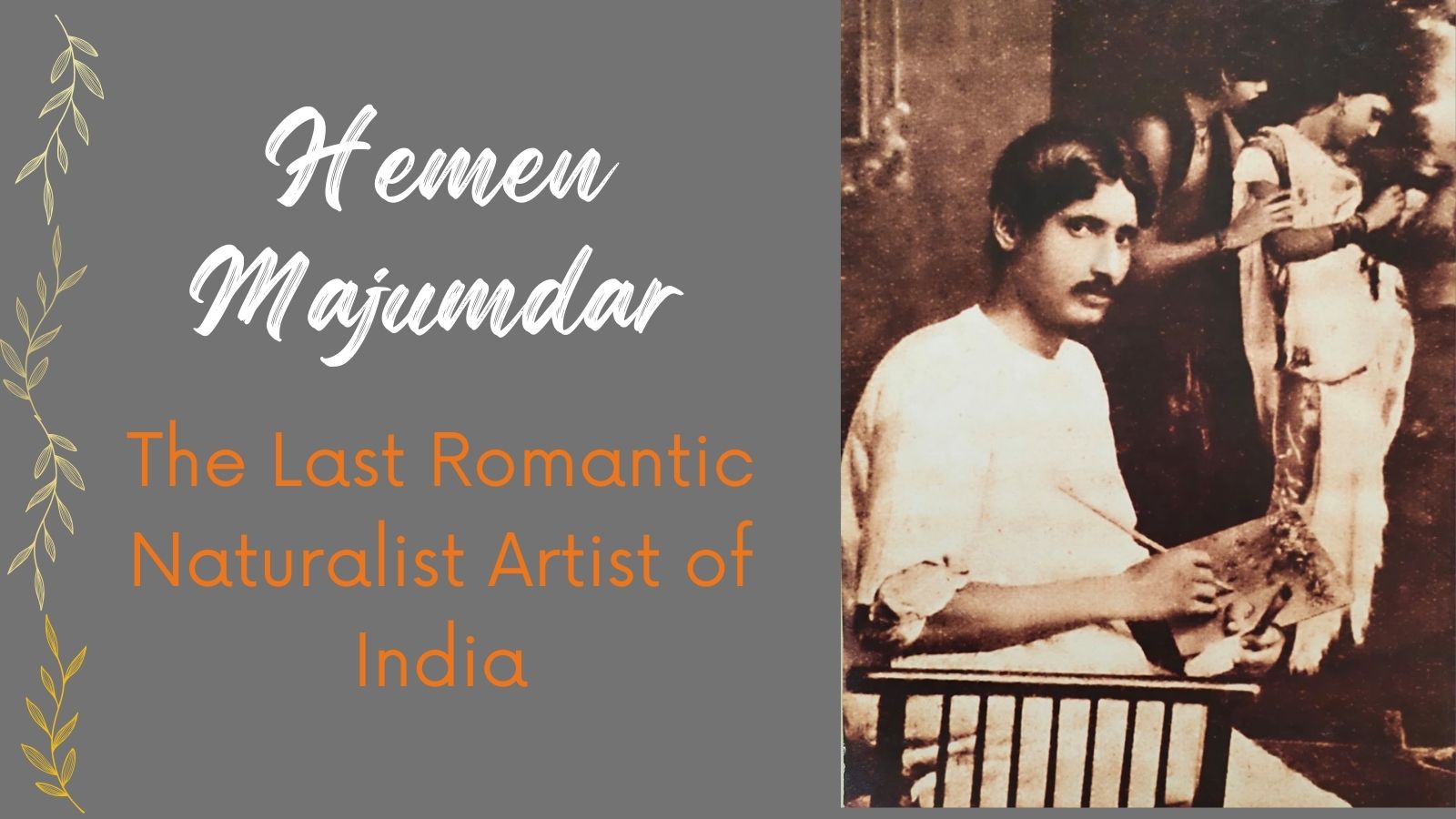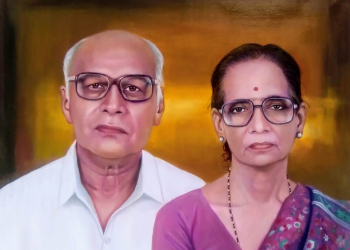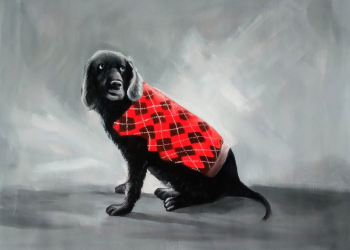We discover Hemendranath Majumder's iconic Wet Sari paintings as we explore the amazing legacy of India's romantic naturalism
Hemendranath Majumder - Birth and Background
Hemendranath Majumder, aka Hemen Majumdar (1898-1948), a gifted romantic naturalist artist and figure painter emerged as a prominent figure in the Indian art scene during the 20th century. Hemedranath Mazumdar was born to a Zamindar family in 1898 in the Gachihata village of Mymensingh district in present-day Bangladesh.
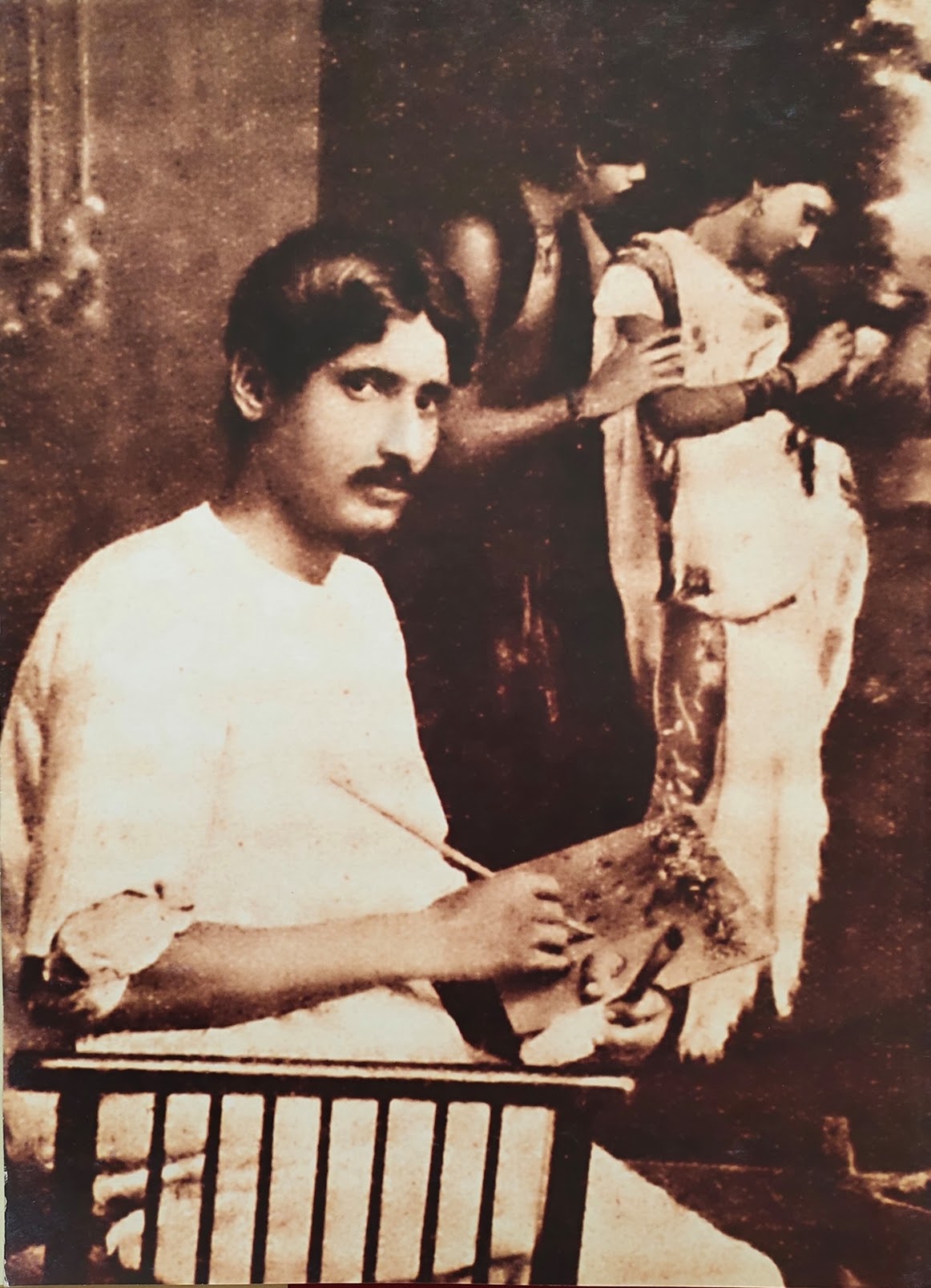 Hemen Majumdar Working In His Studio (Source: Wikimedia.org)
Hemen Majumdar Working In His Studio (Source: Wikimedia.org)
Hailing from a wealthy Zamindari family, he faced stiff opposition from his father about his career choice to be an artist. He fled home to Calcutta, where his sister lived, much against his father's wishes to pursue art along with his childhood friend, portraitist Atul Bose (1898-1977).
Early Training and Education of the Artist
In Calcutta, Hemedranath enrolled in an art school, but his formal education at the art school lasted only a short time. According to noted art historian Partha Mitter, in 1911 he left the art school, “Refusing to join other students in producing artwork to welcome the visiting monarch George V” to join Jubilee Academy. (Note: In online resources like Wikipedia, it has been erroneously claimed that Hemendranath Majumder painted the gates to welcome King George V). His ambition was to learn figure painting but both institutions disappointed him. After a few years at Jubilee Academy, he joined the Government Art School, where his talent and hard work won the highest accolades of the school in his final year, marking the foundation of a journey to redefine Indian art.
Development of his Art
After graduating from art school the three friends, Hemendranath Mazumder, Atul Bose, and Jamini Roy started undertaking art jobs like making paintings from photos & images like couple paintings, wedding paintings, and memorial paintings of deceased loved ones from photos. As noted by Partha Mitter, they undertook jobs like making commissioned memorial paintings of the deceased loved ones for the family based on photographs, “a popular ‘Victorian’ custom in Bengal.” (Much like Paintphotographs does today, making commissioned art and portrait paintings from photos, images, and pics!)
The decade of the 1920s marked a pivotal period that solidified Hemen Mazumdar's standing as a prominent Indian artist, garnering him a nationwide reputation. Commencing in 1920, Mazumdar's artistic prowess was repeatedly recognized as he clinched the gold medal at the annual exhibition of the Bombay Art Society for three consecutive years. His crowning. achievement was the coveted gold medal for society, bestowed upon his masterpiece, "Smriti" (Memories), in 1920. Previously only one artist had won three consecutive prizes at the Bombay Art Society, Manchershaw Pithawalla in 1894.
However, not everyone greeted his success with applause. Journalist Kanhaiyalal Vakil of the Bombay Chronicle voiced discontent, grumbling, "One Mr. H. Mazumdar of Calcutta won three times the first prize of the Exhibition. It is a disgrace to the Bombay artists... Either the Judging Committee must be incompetent or Mr. Mazumdar is too high for the exhibition." Notably, his masterpiece "Pallipran" (Soul of the Village) also secured accolades at exhibitions held in Calcutta and Madras during this period.
By 1926, Mazumdar celebrated his maiden financial triumph as a commercial firm acquired the reproduction rights to his painting "Village Love" for a substantial sum. This painting, in turn, became the focal point of the firm's annual calendar.
Mazumdar's large sensual oil painting depicted partially disrobed or nude women, immersed in their daily chores like bathing and dressing. Maharajas from Jaipur, Bikaner, Kotah, Kashmir, Cooch Behar, Mayurbhanj, Patiala, and other princely states were fascinated by the intimacy and voyeuristic eroticism of Hemendranath’s paintings and soon he started getting commissions from Indian aristocracy.
In 1931, the Maharaja of Kashmir extended a gracious invitation, beckoning Majumder to live and paint in the picturesque landscape of Kashmir. Subsequently, from 1932 to 1938, he held the esteemed position of Court Artist for the Maharaja of Patiala.
Among these aristocrats, the Maharaja of Patiala, Sir Bhupindranath Singh (1891–1938), emerged as the most ardent patron. Singh appointed Mazumdar a state artist for an extensive five-year tenure, offering a generous salary. The magnificence of Mazumdar's creations was reflected in their price tags, with some of Hemendranath Majumdar’s works commanding as much as Rs. 15,000 —an exceptionally substantial sum for that era. But the value of his work has only gone up.
In January 2023 it was reported one of Hemendranath Majumder’s oil painting works, Radha & Krishna, was auctioned for USD 37 million, (INR 3.7 cr). The paintings were auctioned at the "Historic Masterpieces" auction organized by the Indian art auction platform AstaGuru
Order Your Oil Portrait Painting on Canvas from Photo Today
The Wet Sari Effect: The Signature Style of Hemedranath Majumder
By 1921, Mazumdar's prolific body of work had birthed an entirely novel genre of figure painting in India. This genre reveled in the sensual attributes of the female body, focusing on the unattainable upper-class elite Bengali woman. Mazumdar's iconic representation of the Bengali woman, adorned in a 'wet sari,' swiftly emerged as his distinctive signature style.
The term The Wet Saree effect was first used by art historian Partha Mitter, to describe the style of painting pioneered by Hemedranath. Majumdar’s acclaim is primarily anchored in his erotic depictions of women in the 'la drape mouillée' style, seldom fully unclothed. These artworks strategically hint at articles of clothing, emphasizing the figure rather than concealing it. The subjects were usually rural maidens immersed in leisurely pursuits, from bathing to being lost in reverie. His forte lay in his distinctive portrayal of the back view of female subjects, allowing him to skillfully unveil the sensuous layers and folds of smooth youthful flesh, delicately hinting at muscles and bone structure. The master painter, Hemendranath often employed chiaroscuro and sfumato painting techniques, first used by Leonardo da Vinci in Monalisa, in his oil paintings. A noteworthy aspect is the deliberate depiction of mature, presumably married women.
Notable Painting Works of Hemendranath Mazumder
Smriti (Secret Memory)
Smriti (Secret Memory) by Hemendranath Majumder was awarded the Gold Medal in 1921 by the Bombay Art Society in their annual exhibition. In this captivating portrayal, a bare-bodied woman sits on a bed, her white sari clenched around her breasts, delicately concealing them. With her face downturned and eyes closed, she emanates an aura of intimacy and introspection. The thick gold amulets adorning her figure add a touch of opulence, while her untied hair gracefully falls over one shoulder.
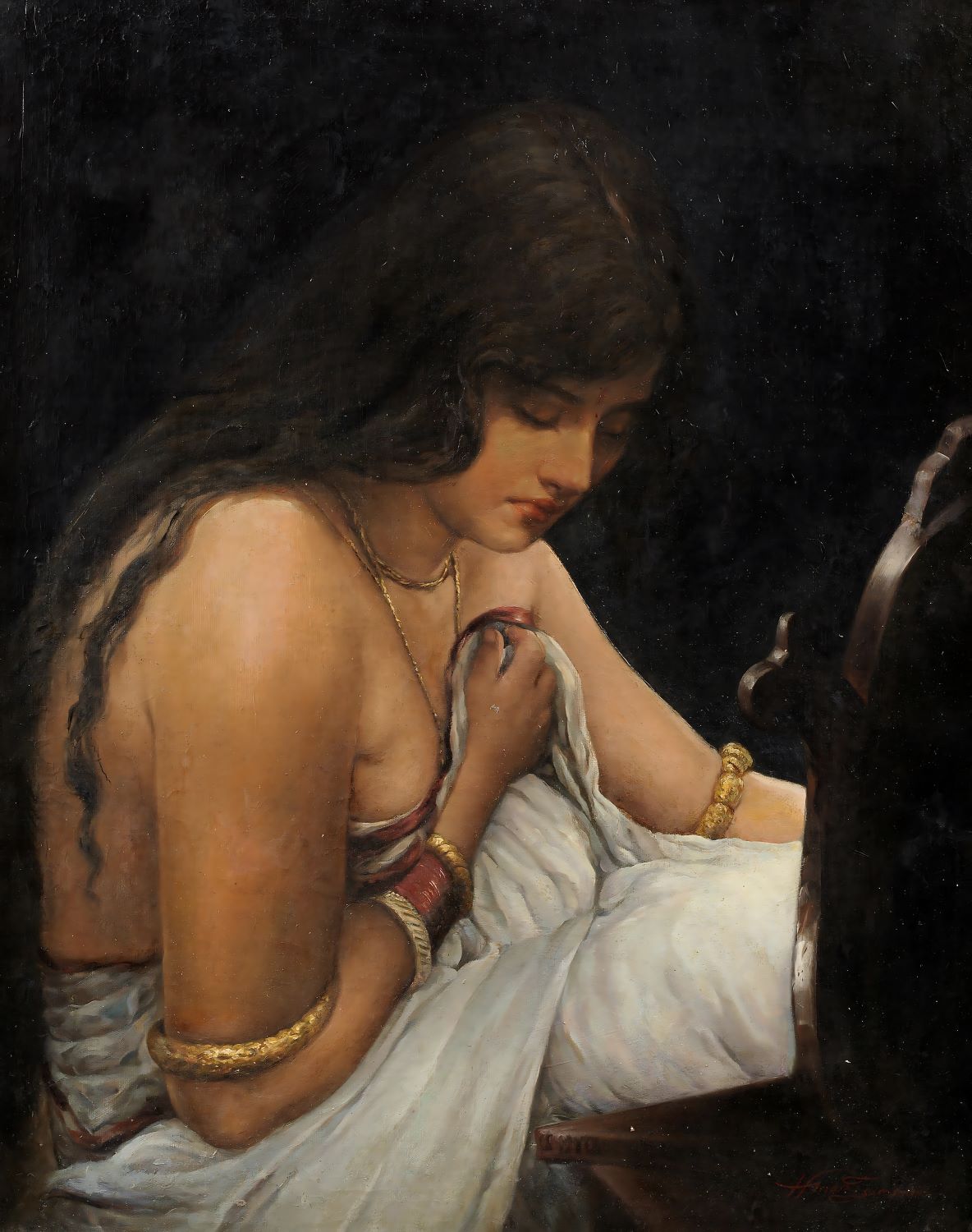 Smriti (Secret Memory) oil painting by Hemen Majumdar (Source: Bonhams.com)
Smriti (Secret Memory) oil painting by Hemen Majumdar (Source: Bonhams.com)
Title: Smriti (Secret Memory)
Date created: 1921
Creator: Hemendranath Majumdar
Medium: oil painting on canvas
Size: 28.94 inches x 23.03 inches (73.5x58.5 cm)
Her hand, adorned with a myriad of red and white bangles, gracefully holds the folds of the sari against her chest. A thin gold chain adorns her neck, disappearing below the draped fabric. The luminosity of her fair skin stands out against the dark background of the room, creating a striking visual contrast.
Positioned in front of her is an old dressing table, complete with a mirror, serving as a silent witness to the aftermath of an amorous encounter. The atmosphere captured in the painting suggests that she cherishes the intimate moments, reliving them in her memory. Even with her eyes closed, her facial expression conveys a sense of profound satisfaction and nostalgia.
From the meticulously rendered folds of her loosened sari to the radiant glow of her skin, the artist's brush skill shines through in creating a painterly effect that enhances the overall emotional depth of the scene. The nuanced atmosphere and detailed composition masterfully convey the complexity of human emotion and memory.
Palli Pran
"Palli Pran" (The Soul of the Village), unveiled at the inaugural exhibition of the Society of Fine Arts in 1921, stands as one of the artist's most triumphant embodiments of this distinctive 'wet sari' technique, now widely recognized as his signature style. This masterpiece portrays a rustic maiden returning home in a wet sari after her daily dip in the village pond, offering the artist an exquisite canvas to showcase the model's fleshy buttocks and rounded shoulders subtly visible through the damp cloth.
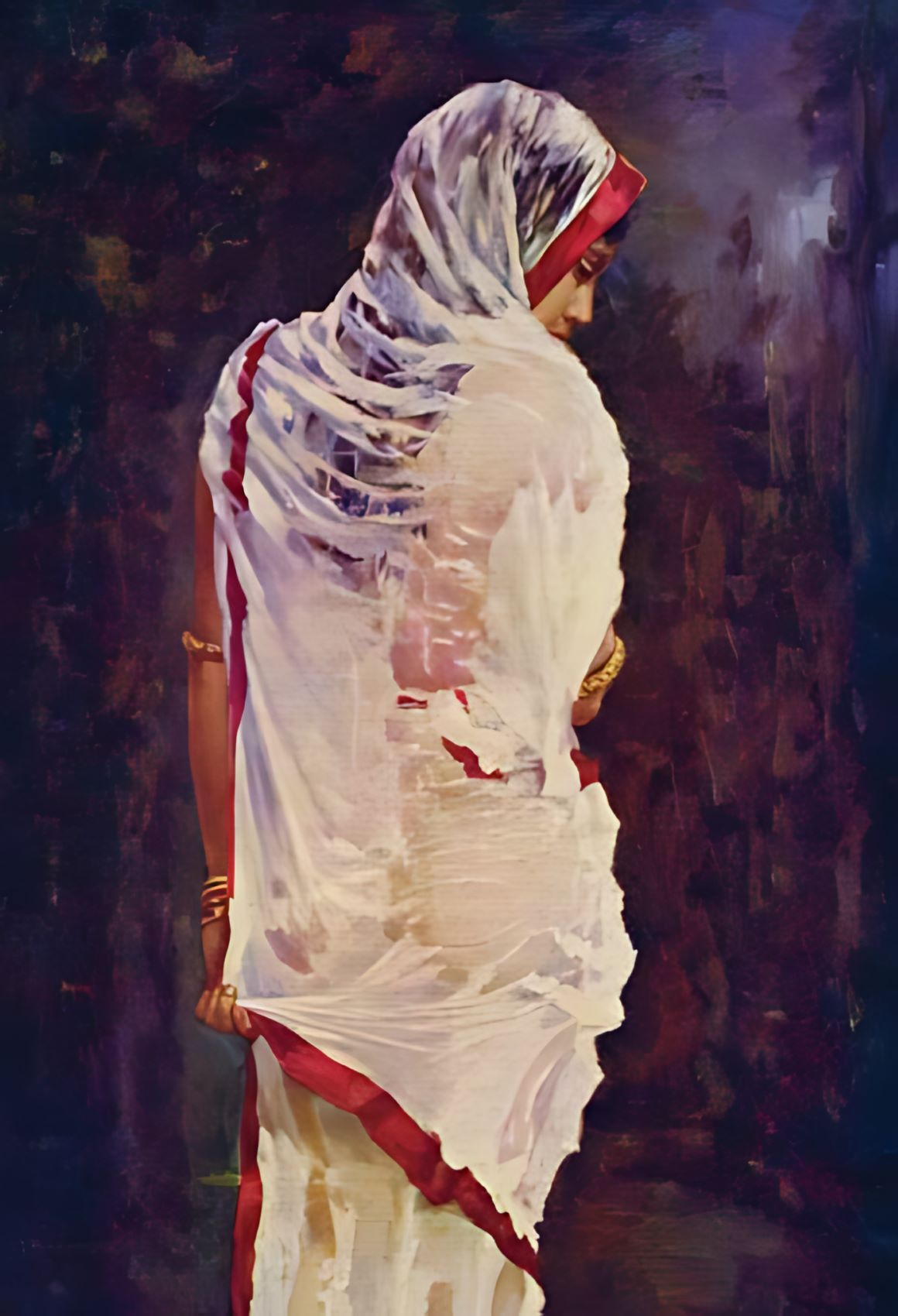 Palli Pran Oil Painting On Canvas By Hemen Majumdar (Source: The Triumph of Modernism: India's Artists and the Avant-Garde)
Palli Pran Oil Painting On Canvas By Hemen Majumdar (Source: The Triumph of Modernism: India's Artists and the Avant-Garde)
Title: Palli Pran
Date created: 1921
Creator: Hemendranath Majumdar
Medium: oil painting on canvas
Size: 35.5 inches x 24.21 inches (90.3 x 61.5 cm)
Meticulously, he portrayed the rounded nape of her neck, the fleshy contours of her shoulders, the small of her back, the concave curvature of the spinal column, and the allure of her hips and firm buttocks. Despite the clever suggestion of a frozen moment, the artwork was a carefully executed studio creation. To capture the nuances of the particular pose, the artist also employed the aid of photographs in his meticulous process.
Dilli Ka Laddu
Another notable painting of Heme, capturing translucent flesh tones materialized in a grand and ambitious oil painting nude, provocatively titled "Dilli ka Laddu," loosely translated as 'The Obscure Object Of Desire.'
In this evocative painting, a woman stands gracefully in a room, her back turned towards the viewer as she endeavors to drape a sari. The artist has employed a palette of soft and sensual hues, creating an atmosphere that exudes both intimacy and subtlety. The subject, with fair skin, retains an air of mystery as her face remains entirely concealed from the observer.
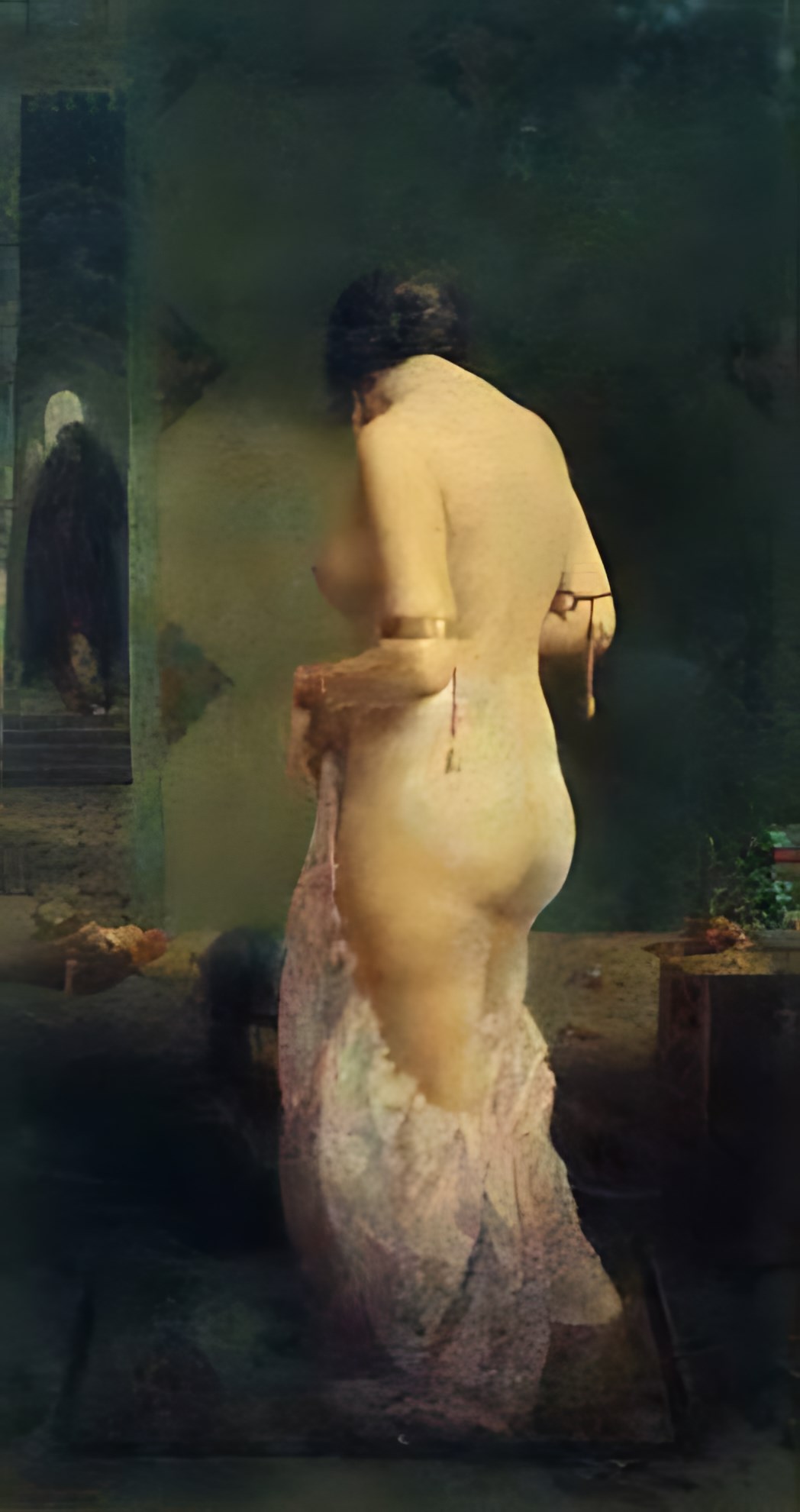 Dilli Ki Laddoo Oil Painting On Canvas By Hemendranath Majumdar((Source: The Triumph of Modernism: India's Artists and the Avant-Garde)
Dilli Ki Laddoo Oil Painting On Canvas By Hemendranath Majumdar((Source: The Triumph of Modernism: India's Artists and the Avant-Garde)
Title: Dilli Ki Laddoo
Creator: Hemendranath Majumdar
Medium: oil painting on canvas
Size: 28.94 inches x 23.03 inches
One breast is subtly visible, lending an element of vulnerability to the composition. The artist skillfully captures the delicate interplay of light and shadow, adding a nuanced dimension to the depiction. The room's walls, painted in a rich dark green, serve as a contrasting backdrop, enhancing the overall ambiance of the scene.
Adorning the woman are golden amulets, imparting a touch of opulence and cultural significance. This choice of detail not only adds aesthetic charm but also contributes to the narrative of the painting. The artist masterfully navigates between elements of sensuality, modesty, and cultural symbolism, crafting a captivating visual narrative that invites contemplation and introspection.
Untitled Work
In this untitled alluring tableau, a nude woman stands in a pond, enveloped by the delicate folds of a wet sari after a refreshing bath. The artist, employing a dreamy and sensual palette, captures a mesmerizing moment of contemplation. The woman, her gaze directed downward, peers into the water as if entranced by her reflection.
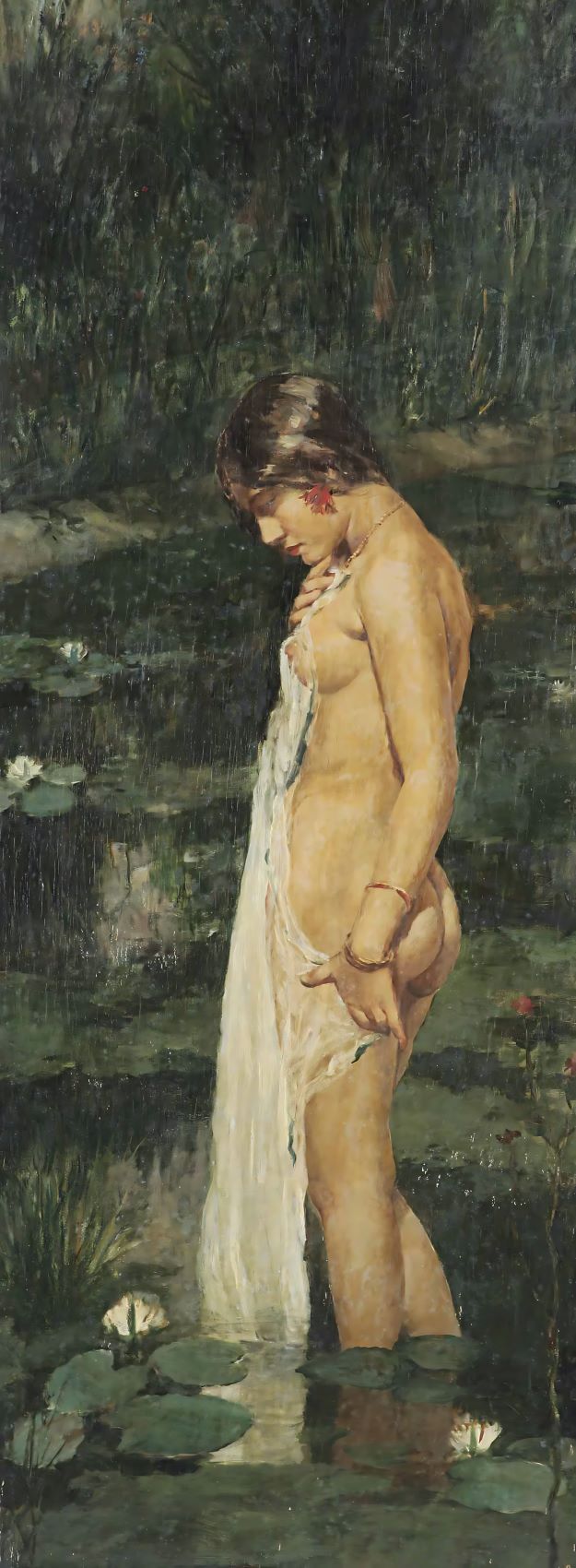 Untitled Oil Painting On Canvas By Hemendranath Mazumdar (Source: The Triumph of Modernism: India's Artists and the Avant-Garde)
Untitled Oil Painting On Canvas By Hemendranath Mazumdar (Source: The Triumph of Modernism: India's Artists and the Avant-Garde)
Title: Untitled
Date Created: 1930's
Creator: Hemendranath Majumdar
Medium: oil painting on canvas
Size: 50.5 inches x 20 inches (127.6 x 50.8 cm)
Adorning her ears are vibrant red hibiscus flowers, elegantly serving as makeshift earrings, imparting a touch of natural adornment to the scene. Drops of water glisten on her skin, catching the ambient light and adding a subtle luminosity to her form. The composition radiates a serene sensuality, inviting viewers into a world where the ethereal meets the earthly.
The pond, nestled in a forested area, becomes a tranquil sanctuary adorned with water lily leaves and delicate white blossoms afloat. The artist expertly navigates the interplay of light and shadow, creating an atmosphere that feels both intimate and otherworldly. This painting, a testament to the convergence of nature and the human form, invites contemplation into the beauty of the ephemeral moment captured on canvas.
Wounded Vanity
In this striking composition by Majumder, a barebacked woman draped in a regal purple sari leans against a darkened wall, her back turned to the viewer. The atmosphere resonates with a palpable sense of vulnerability and hurt vanity. With her head buried in the crevice between her arms, she conceals her face against the wall, holding two delicate white flowers.
The woman's perfectly coiffed hair, secured by a golden hairband, frames her face in a striking silhouette. Adorned with golden bangles and amulets, her hand delicately clutches the blossoms, while a golden waist ring graces her alluring figure. The artist's naturalistic portrayal is evident in the woman's perfectly arched back, capturing a moment of raw emotion.
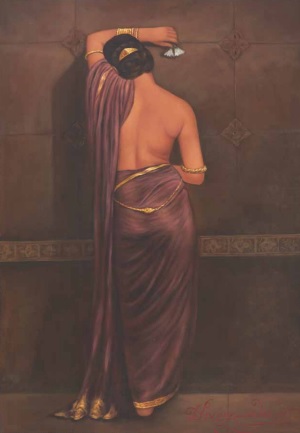 Wounded Vanity Oil Painting On Canvas By Hemendranath Mazumdar (Source: The Triumph of Modernism: India's Artists and the Avant-Garde)
Wounded Vanity Oil Painting On Canvas By Hemendranath Mazumdar (Source: The Triumph of Modernism: India's Artists and the Avant-Garde)
Title: Wounded Vanity
Creator: Hemendranath Majumdar
Medium: oil painting on canvas
Size: 33.86 inches x 23.78 inches (86x60.4 cm)
Through the cascading folds of her purple sari, one discerns the outlines of her enticing buttocks, revealing Majumder's keen attention to detail. The stark contrast between the bare, darkish wall and the luminosity of her fair skin creates a compelling visual tension.
The overall mood of the painting is poignant, conveying a narrative of wounded vanity and pride, perhaps inflicted by a lover. The interplay of light and shadow, coupled with Majumder's meticulous rendering, invites viewers to delve into the emotional depths of the depicted moment.
As can be seen from the above Hemendranath Majumder was a master artist. His skills with the brush, his technique of applying paint whether alla prima (wet on wet) or fat over lean, and his exquisite draftsmanship were unparalleled and unrivaled in India during his time. He was the most talented figure painter and artist in India.
Order Your Portrait Painting from Photo Today
The Implacable Critic of Bengal School of Art
Even with his commercial success, Hemendranath a proponent of academic naturalism, and his friends increasingly found themselves sidelined in the art world dominated by the historicism of the Bengal School of Art led by Abanindranath Tagore. As Partha Mitter so eloquently put it, “The burning issue of the day was whether the pursuit of naturalism was tantamount to a betrayal of national ideals and whether the historicism of the Bengal School was the sole path to India’s artistic revival.”
The Orientalists were able to wrangle subsidies from the Government to bring out their scholarly art journal Rupam. To counteract the influence of Rupam, Hemen, suggested bringing out their art journal to highlight the development of academic art. Hemendranth alongside stalwarts like Jogeshchandra Seal, Jamini Roy, Bhabani Charan Law, and Atul Bose, founded the Indian Academy of Fine Art in 1920 in Calcutta setting the stage for a revolutionary artistic movement. Sukumar Roy, a popular children's author, and father of filmmaker Satyajit Roy, came to their aid and agreed to publish their journal from his printing press.
The Indian Academy of Fine Art also held exhibitions in support of the artist community, the first of which was held in December 1921- January 1922, which exhibited over 1000 paintings and artworks from artists from all over India. The second exhibition was held in December 1922-January 1923 and received media coverage. Atul Bose’s ‘Bengal Tiger’ a portrait sketch of Sir Asutosh Mukherjee won him a scholarship to the Royal Academy in London.
The years spanning from 1920 to 1924 witnessed the publication of the comprehensive five-volume set, "The Art of Mr. H. Mazumdar," showcasing the breadth and depth of his creative portfolio. Concurrently, Mazumdar's paintings found a recurring presence in various magazines and periodicals, attesting to the widespread acclaim he was gaining. In another move to propagate his art to a broader audience, Mazumdar curated an album of paintings titled "Indian Masters," edited by A.M.T. Acharya in the 1920s. This album served as a platform to showcase the diversity and richness of his artistic expression.
In a 1929 edition of the Illustrated Journal of Fine Arts, Hemen Majumder penned an article titled 'The Making of a Picture,' elucidating his artistic methodologies. In this exposition, he delineated a modus operandi aligning with the prevalent academic technique favored by the British. His approach involved an initial phase of producing preparatory sketches, followed by more intricate pencil and wash studies, culminating in creating a meticulously structured final painting. Mazumdar's oeuvre echoed the tradition set by Raja Ravi Varma, delving into a comparable spectrum of themes with a primary focus on idealized, sensual studies of the female form.
The Indian Academy of Fine Art Journal was well-received by art enthusiasts and the general public. However, it did not prove to be a commercial success. In 1929, Mazumdar ventured into the realm of the editorial by launching a new art journal, "Shilpi," a testament to his commitment to fostering dialogue around art and culture.
Throughout his life, Mazumdar continued his polemical attacks on historicism, the ideological foundations of the Bengal School. History painting, he contended, was out of touch with contemporary India. Believing in the universality of mimetic art. He held that only direct observation of nature could provide an objective standard. Mazumdar waged a relentless war against the orientalist. In a late article, just before his death, ‘Cobwebs of the Fine Arts World’, he summed up his contempt for the ‘authenticity’ of the Bengal School, claiming that their inability to draw was camouflaged by their assertion of a ‘spiritual’ world beyond appearances. In retrospect, this was perhaps a harsh comment to make. For Bengal School of Art did give rise to many talented artists like Sunayani Devi, Nandalal Bose, M.A.R Chughtai, Sudhir Khastgir, and Kshitindranath Majumdar.
Hemendranath Majumder’s Exhibitions
Majumder's participation in various exhibitions across the country solidified his position as a distinguished artist. From the Bombay Art Exhibition in 1921 to the New Delhi Exhibition in 1939, and the All India Exhibition in Calcutta in 1948, his works consistently captivated audiences. Notable exhibitions in 2004 and 2005, organized by the Delhi Art Gallery, further underscored the enduring impact of Majumder's artistic contributions.
Hemendranath Majumder Collections
Hemen Majumder's works found homes in prestigious collections, including the Academy of Fine Art in Kolkata, Bikaner Palace in Rajasthan, Birla Academy of Art and Culture in Kolkata, and the National Gallery of Modern Art in New Delhi. His art adorned the private collections of esteemed figures like the royal families of Mayurbhanj, Maharaja Prafulla Thakur, Maharaja Ranjit Singh, Maharaja Hari Singh, and Maharaja Jadabendranath Singh.
Praise and Awards won by Hemedranath Majumder
Hemen Majumder's artistic odyssey was punctuated by a prolific array of exhibitions, each serving as a testament to his evolving style and the thematic richness that defined his work. The Bombay Art Exhibition in 1921 marked his debut on the grand stage, showcasing early glimpses of his artistic brilliance. Subsequent exhibitions in Madras in the same year and others like "Barna Jhankar" and "Kardame Kamal" in 1922 and 1923 provided fertile ground for Majumder to experiment with diverse styles and themes.
The grandeur of his artistic vision reached its zenith with exhibitions held in iconic venues such as Eden Gardens in Calcutta. This city became a canvas for the unfolding narrative of Indian art. His participation in the 1939 New Delhi Exhibition brought his work to the attention of a wider audience, marking a significant stride in the recognition of his artistic contributions.
In 1940, Majumder's exhibition at Chowringee Terrace, inaugurated by the Queen of Coochbehar, was a cultural spectacle that underscored his ability to bridge art and societal celebration. The All India Exhibition in Calcutta in 1948 was another milestone, solidifying his stature as a luminary in the Indian art scene. Hemen Mazumdar died on 22 July 1948.
The early years of the new millennium witnessed a resurgence of interest in Majumder's oeuvre. Exhibitions such as "Manifestations II" in 2004 and "Manifestations III" in 2005, organized by Delhi Art Gallery, retrospectively celebrated his enduring influence. These exhibitions not only showcased the timelessness of his creations but also provided a platform for a new generation to appreciate the depth and diversity of his artistic legacy.
Alongside Jamini Roy and Rabindranath Tagore, Hemen Mazumdar played a pivotal role in shaping the landscape of "modern Indian art." Their distinct, albeit competing, visions drew inspiration from Indian folk art, expressionism, and Western academic styles. This tripartite legacy continues to resonate in contemporary Indian visual art, forming an enduring foundation for artistic exploration and innovation.
About Us:
Paintphotographs.com is India's leading custom art platform. We turn your favorite photos, pics, and images into luxurious handmade portrait paintings. Our work includes handmade portraits, custom oil reproductions, charcoal drawings, and sketches. As a team of accomplished artists, we use museum-quality canvas, the best international brands of colors such as Winsor & Newton and Daler Rawney. We work with various mediums, including oil, acrylic, mixed media, graphite, and charcoal.
To order a custom handmade oil portrait painting you can visit our order now page. You can order custom Wedding Paintings, Couple Paintings, Memorial Paintings, Family Paintings, Baby portraits and Children Paintings, Photo to paintings, and Pet Portrait Paintings from Photo.
You can visit our pricing page to know the prices of our portrait paintings. To connect with us ping us on our chat messenger on the website, ping us on WhatsApp, call us at 918291070650, or drop us an email at support@paintphotographs.com
You can visit our gallery pages to see our work. We make photo to paintings, couple paintings, memorial paintings, Kids and Baby Portrait paintings, God & Religious Paintings, Old Photo to Paintings, Wedding couple Paintings & Marriage Portraits, Family Paintings, Pet Portrait Paintings, Radha Krishna Paintings, Oil Portraits of Gurus, Saints & Holy Men, Charcoal and Pencil Sketches, Custom Landscape & Cityscape paintings, Contemporary Art Reproduction & Replica Paintings, Old Master Reproduction & Replica Art, Monochrome and Black & White portrait paintings, Historical Portraits and Shivaji Maharaj Paintings, Celebrity & Political Leaders Portraits. We can also merge separate photos to create a single seamless painting called Composite portraits to add deceased loved ones to make a family oil portrait as though they were present.
Our custom handmade portraits make beautiful Anniversary Gifts, Engagement Gifts, Birthday Gifts, Retirement Gifts, Housewarming Gifts, Mother's Day gifts, and luxurious gifts for many important occasions.
Paintphotographs.com provides bespoke services for art patrons, interior designers, and architects. It helps you create the perfect pieces for residential and commercial projects and serves as a platform for artists to showcase their work.
If you are an art aficionado interested in writing a guest post on art, connect with us.
Want to read more? Check our reading recommendations below! Please refer to the Notes and Reference section for sources referenced in the article.
Like this story? Then you will love our podcasts on Spotify. Listen to our deep dives and fascinating stories from the art world. Join our nearly 20,000-strong community on Facebook, WhatsApp, and X.
Want to see our art? Join our community of 500,000+ subscribers on the Paintphotographs YouTube channel, Instagram, and Pinterest for some amazing art pics & art videos!
Recommended Pieces
100 Years of Bharat Mata: 9 Iconic Indian Artworks by Legendary Artists | Paintphotographs
Sunayani Devi: The Naive Primitivist Who Pioneered Modern Indian Art | Paintphotographs
How to Convert Your Photo into a Canvas Portrait Painting Online - Handmade
A Closer Look at the Stunning Paintings in Coca-Cola's Latest Ad “Masterpiece” | Paintphotographs
The paintings in John Wick Chapter 4 | Paintphotographs
The life and paintings of artist and painter KCS Paniker | Paintphotographs
Why is Monalisa so famous? Monalisa's portrait painting history | Paintphotographs
Memorial Paintings - The Ultimate Guide to Commissioning one | Paintphotographs
India's Greatest Portrait Painters: Lives of 13 Oil Portrait Painting Masters | Paintphotographs
Ultimate 20 Best Oil Portrait Paintings of John Singer Sargent (Ranked) | Paintphotographs
10 Famous Romantic Raja Ravi Varma Paintings | Paintphotographs
The Artistic Genius of Abanindranath Tagore: Rediscovering His Early Works | Paintphotographs
Notes and reference section
The Triumph of Modernism India's Artists and the Avant-garde, 1922-47 By Partha Mitter
Hemen Mazumdar: The last romantic
Bonhams : Hemen Mazumdar (India, 1894-1948) Smriti (Secret Memory),
HEMENDRANATH MAZUMDAR (1894-1948)
Hemen Mazumdar Work Auctioned For 3.7 Crore | Kolkata News - Times of India

